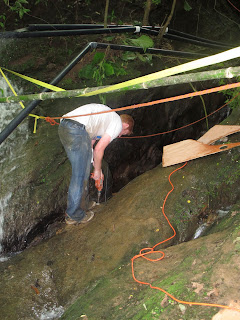Abby and Jinhwa work with the wiring that eventually would connect the generator to the inverter.
Brandyn and Lisbeth cutting PVC pipe
One of the monster spiders keeping our computers company while we worked outside
Jinhwa, Professor Hightower and Alice struggling to mount the heavy inverter, and just before the ceramic expanders failed us.
On Day Four the whole team donned their "Harvey Mudd College: The Most Amazing College You've Never Heard Of" T-shirts, knowing that it would be action packed (and full of photo opportunities!). With the 7am opening of the hardware store we received the crucial valve for the top of the dam that we immediately put in place. We were finally able to finalize and permanently cement in the pipe layout we had been planning for days. Brandyn and Alice worked on drilling clamps into the rock at the upper piping section to secure the pipes, while Lisbeth, Abby, Jinhwa and Professor Hightower continued to work on the electrical system.
Alice gets on the roof to wire the circuit breaker from above
The team in action! Jinhwa drills new holes to mount the inverter while Abby continues to work on the wire system now protected by flexible PVC pipe
At lunch came a much needed break, but also the dreaded rain we had been avoiding for the past four days. Although it only lasted for less than an hour, our already treacherous path up to the dam site was turned into a slick slope with minimal footing. Carrying 6 meter PVC pipes was suddenly much harder, but the team worked together to cement and secure the pipes all the way down to the generator site on flat ground. Without securing the final pipe to the turbine, tests were run to confirm that the pipe and dam system were successful and carried a strong water flow down to the last pipe. Jinhwa, Abby and Professor Hightower mounted the inverter and connected it to both the generator and circuit break. At 5pm we stopped for the day, with only the last pipe to connect and a few electrical details to finalize.
First test for water pressure down at the bottom: Success!
The dorms we hope to power with our hydroelectric station.
The valve, closed, and the dam exposed to the forces of the creek as we slowly broke down our water diversion system.
Lisbeth falling on the path and demonstrating the slickness of this muddy slope! Needless to say we were covered head to toe in mud by the end of the day.
Friday, June 10th, was the team's last day of work for this June visit. Alice and Professor Hightower had to leave early at 11am to catch a flight, while the rest of the team would leave the following morning. We had scheduled this day for troubleshooting, and upon waking up at the usual 6am hour we put the final touches on our system and prepared to run it. By around 8am, we did our first test run, and while we did have constant water pressure at the bottom that spun the turbine, the inverter gave no power reading. After Jinhwa and Hightower tweaked the electrical system, we tried again, but the inverter still did not give the proper readings. We considered four possible reasons for this problem:
1) That we wired the system improperly such that it would run once we addressed this issue
2) The turbine is not operating properly
3) The inverter is not operating properly
4) Both the turbine and inverter are operating properly, but they are not compatible.
The team put an enormous amount of effort into exploring each of these possibilities, long after Alice and Hightower's plane took off in San Jose. After measuring the voltage across almost every set of points and checking the wiring over and over again, reasons 1 and 3 seemed unlikely to be the cause of the problem. Professor Hightower noted that on occasion there was a periodic whine he recognized as the sound of the inverter trying to turn itself on. We were in constant touch with the turbine manufacturers and sent numerous videos of the system, but were unable to identify the source of our problem.
Brandyn turns on the dam by opening the valve.
The Harvey Mudd Costa Rica Project Team with our running turbine.
As the title of this post implies, the story will continue. This team of Harvey Mudd students successfully installed a dam, pipeline and water flow control system that attached to a completed, but defective grid-tied micro-hydroturbine system. We are all very committed to this project and are determined to see the Firecstone center dorms powered by our hydroelectric station. We are in the middle of documenting and planning the next stage of this project so that we can successfully complete the job we set out to do.



































